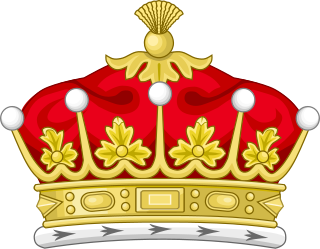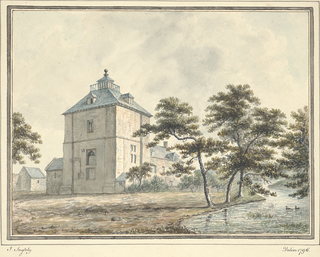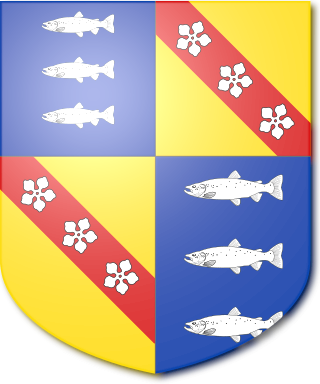
Earl Ferrers is a title in the Peerage of Great Britain. It was created in 1711 for Robert Shirley, 14th Baron Ferrers of Chartley. The Shirley family descends from George Shirley of Astwell Castle, Northamptonshire. In 1611 he was created a Baronet, of Staunton Harold in the County of Leicester, in the Baronetage of England. He was succeeded by his son Henry, the second Baronet, who married Lady Dorothy Devereux, daughter of Robert Devereux, 2nd Earl of Essex. On the death of her brother Robert Devereux, 3rd Earl of Essex, she became the youngest co-heir to the baronies of Ferrers of Chartley and the barony of Bourchier, which had fallen into abeyance on the death of the third Earl. Shirley was succeeded by his eldest son, the third Baronet. He died unmarried and was succeeded by his younger brother, the fourth Baronet. He was imprisoned in the Tower of London by Oliver Cromwell and died there in 1656. On his death the title passed to his eldest son, the fifth Baronet. He died at an early age and was succeeded at birth by his posthumous son, the sixth Baronet.

Baron Middleton, of Middleton in the County of Warwick, is a title in the Peerage of Great Britain, created in December 1711 for Sir Thomas Willoughby, 2nd Baronet, who had previously represented Nottinghamshire and Newark in Parliament. It was one of twelve new peerages created together and known as Harley's Dozen, to give a Tory majority in the House of Lords.

Earl of Verulam is a title in the Peerage of the United Kingdom. It was created in 1815 for James Grimston, 4th Viscount Grimston. He was made Viscount Grimston at the same time. Verulam had previously represented St Albans in the House of Commons. In 1808 he had also succeeded his maternal cousin as tenth Lord Forrester. He was succeeded by his son, the second Earl.

Earl of Pomfret was a title in the Peerage of Great Britain created in 1721 for Thomas Fermor, 2nd Baron Leominster. The title became extinct upon the death of the fifth earl in 1867.

Sir John Anstruther, 1st Baronet was a Scottish politician who sat in the Parliament of Scotland from 1702 to 1707, and in the British House of Commons from 1708 to 1741.

The Arnot Baronetcy was a title in the Baronetage of Nova Scotia. It was created on 27 July 1629 for Michael Arnot with remainder to heirs male whatsoever. His grandson, the second Baronet, represented Kinross in the Scottish Parliament. The title became extinct or dormant on the death of the ninth Baronet in 1838.
Sir David Dalrymple, 1st Baronet, of Hailes was a Scottish advocate and politician who sat in the Parliament of Scotland from 1698 to 1707 and in the British House of Commons from 1707 to 1721. He served as Lord Advocate, and eventually Auditor of the Exchequer in Scotland in 1720.
There have been five baronetcies created for people with the surname Napier, three in the Baronetage of England, one in the Baronetage of Nova Scotia and one in the Baronetage of the United Kingdom. As of 2014 two of the creations are extant.

There have been four baronetcies created for persons with the surname Hope, three in the Baronetage of Nova Scotia and one in the Baronetage of the United Kingdom. As of 2010 one creation is extant, one dormant and two extinct.

The Hamilton baronetcy of Preston, Haddingtonshire was created in the Baronetage of Nova Scotia on 5 November 1673, for William Hamilton, eldest son of Sir Thomas Hamilton, of Preston and Fingalton, by his second wife, Anne Hamilton, of Preston. He married in 1670 Rachel Nicolson of Cockburnpath, but left no male issue, sold his estates, and died c.1690, having left Scotland for the Netherlands. The title passed to his brother Robert, 2nd Baronet. On his death, the title was regarded as dormant, until legal cases in the 19th century saw it revived, and imputed to successors. The name was changed to Stirling-Hamilton in 1889.
The Edmonstone Baronetcy, of Duntreath in the County of Stirling, is a title in the Baronetage of Great Britain. It was created 20 May 1774 for Archibald Edmonstone, 11th of Duntreath, Member of Parliament for Dunbartonshire and Ayr Burghs. He was succeeded by his third but eldest surviving son, the second Baronet. He represented Dunbartonshire and Stirlingshire in the House of Commons. On his death the title passed to his eldest son, the third Baronet. He was a writer and traveller. He died without surviving issue and was succeeded by his half-brother, the fourth Baronet. He was an admiral in the Royal Navy and Member of Parliament.

There have been two baronetcies created for persons with the surname Leighton, one in the Baronetage of England and one in the Baronetage of the United Kingdom. One creation is extant as of 2010.
There have been three baronetcies created for persons with the surname Foulis, one in the Baronetage of England and two in the Baronetage of Nova Scotia.
There have been four baronetcies created for persons with the surname Seton, all in the Baronetage of Nova Scotia. As of 2008 one creation is extant, one dormant and two extinct.

There have been two baronetcies created for members of the Barkham family, both in the Baronetage of England. Both creations are extinct.
Sir William Grierson, 2nd Baronet, of Rockhall, Lag, Dumfries, was a Scottish Jacobite and Tory politician who sat in the House of Commons from 1709 to 1711. He was captured and imprisoned in the 1715 Jabobite rebellion.

The Vanacker, later Sambrooke Baronetcy, of London, was a title in the Baronetage of England. It was created on 31 January 1701 for the Turkey Merchant Nicholas Vanacker, with a remainder failing male issue of his own or his brother John Vanacker to Sir Jeremy Sambrooke and the heirs male of his body. The Vanacker line failed on the death of the second Baronet in 1711 and the title was inherited by Sir Samuel Sambrooke, the third Baronet, who sat as Member of Parliament for Bramber and Great Bedwyn. The fourth Baronet was a Member of Parliament for Bedford. The title became extinct on the death of the fifth Baronet in 1754.
The Denham of Westshield Baronetcy was created on 31 January 1693 in the Baronetage of Nova Scotia for William Denham.
Lieutenant-General Sir John Bruce Hope, 7th Baronet was a Scottish soldier and politician who was 7th Baronet Hope of Craighall.

Sir Alexander Cumming, 1st Baronet (c.1670–1725) of Culter, Aberdeen, was a Scottish landowner and Tory politician who sat in the House of Commons from 1709 to 1722.











